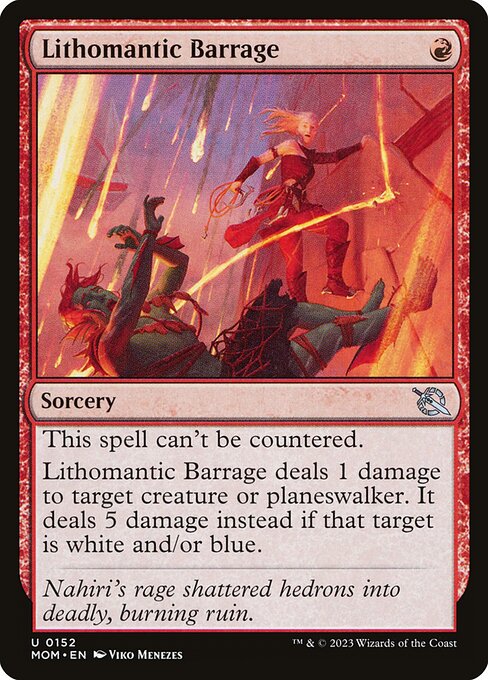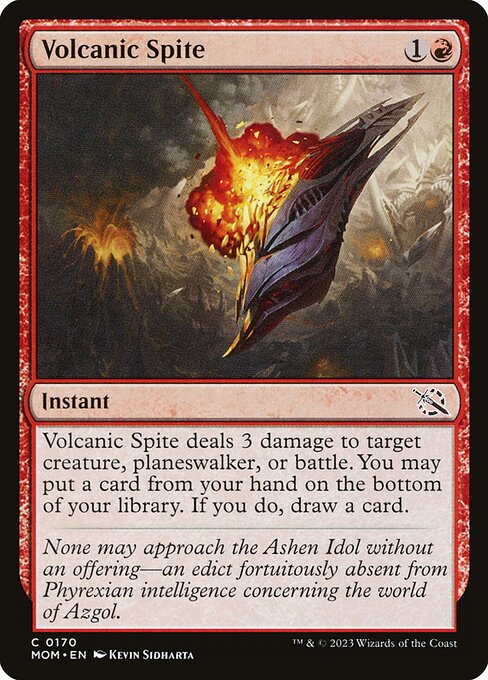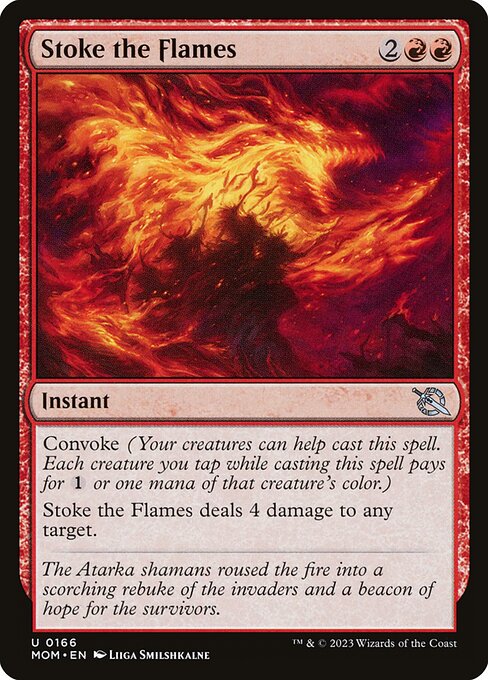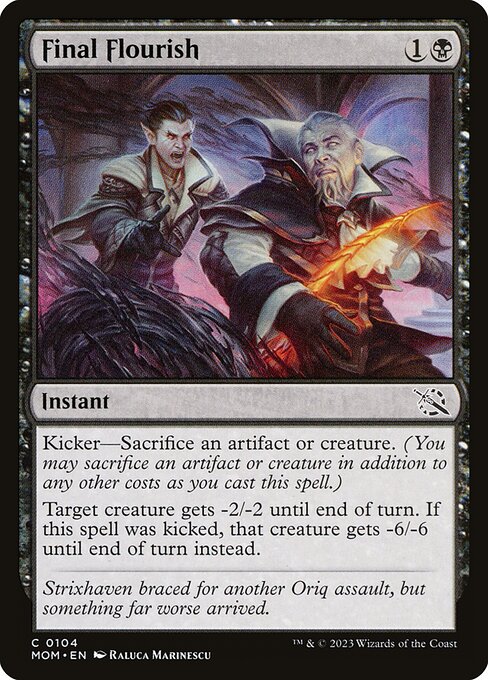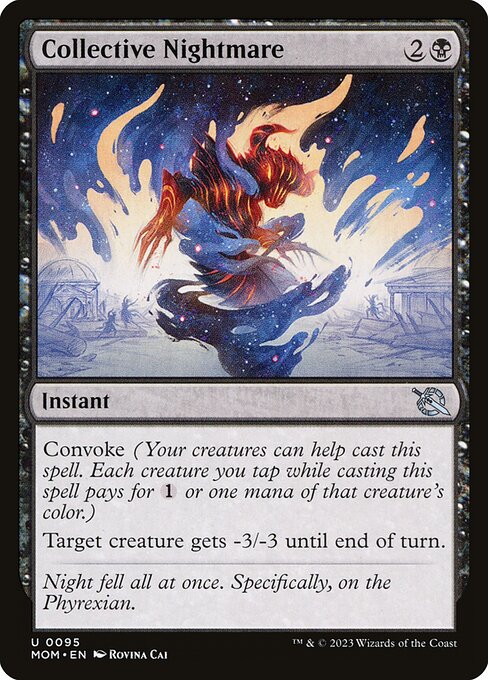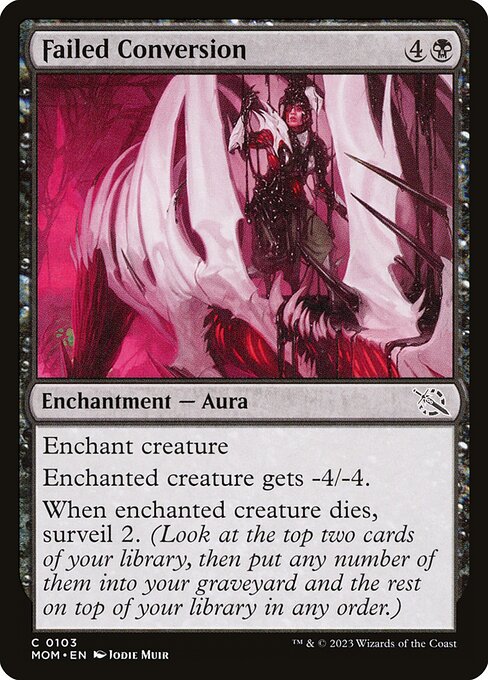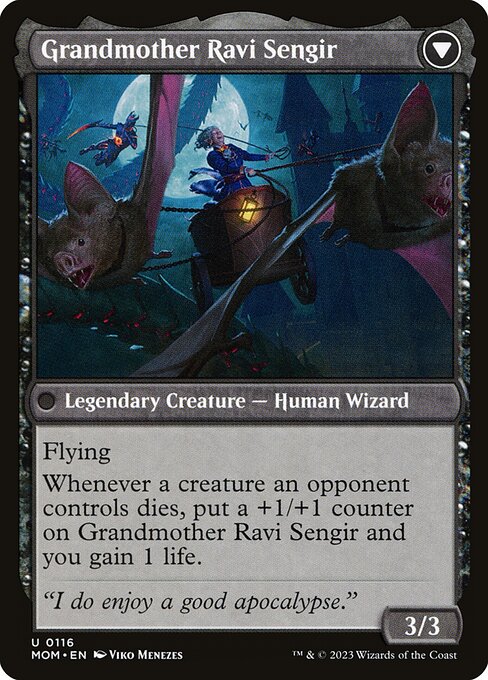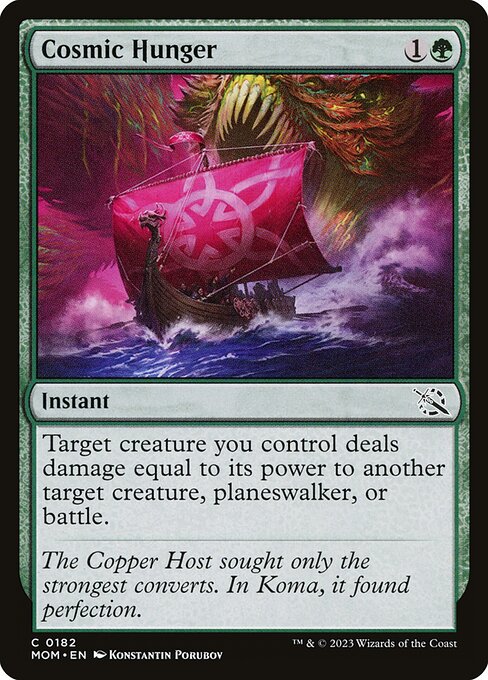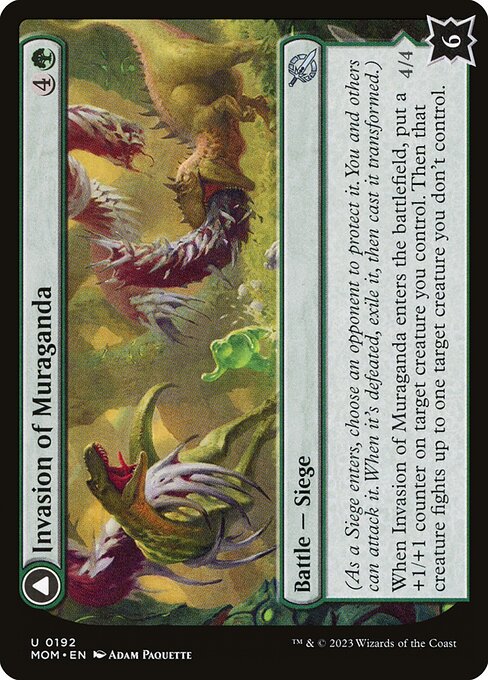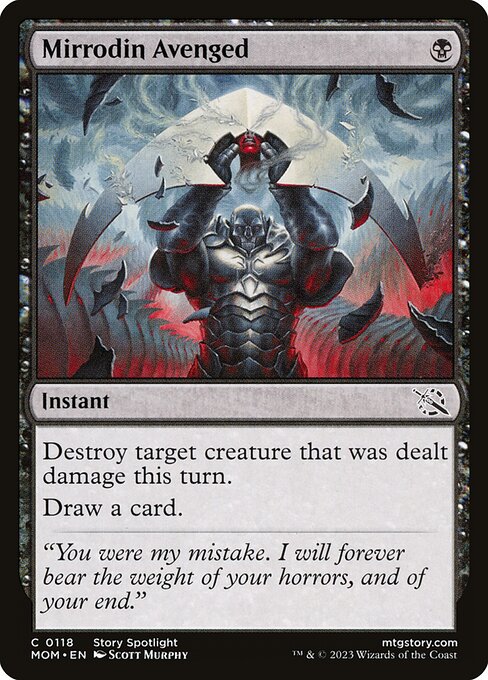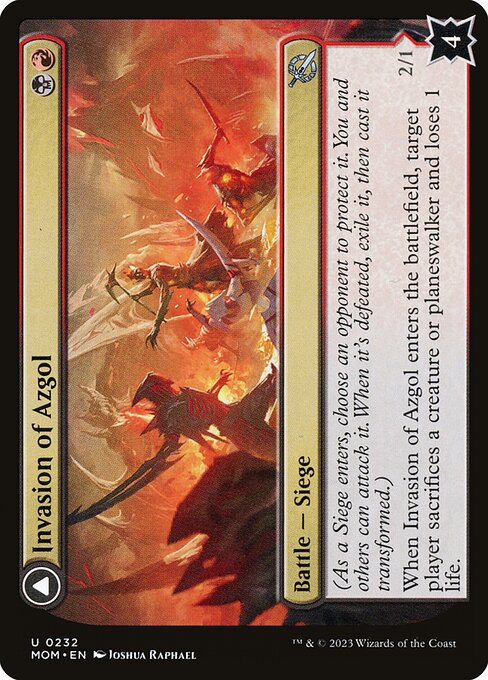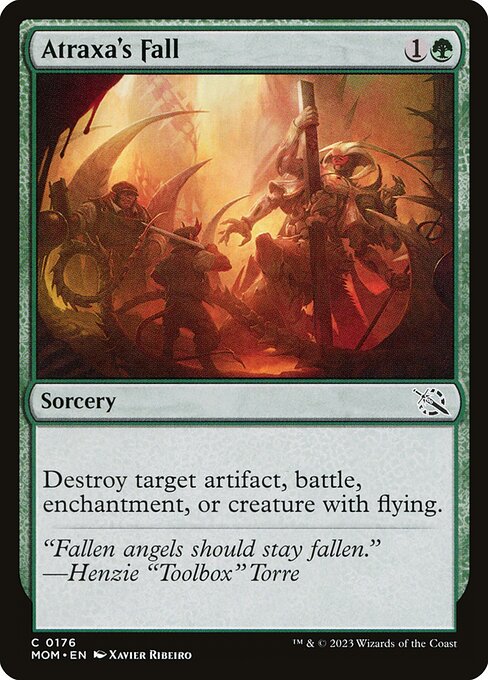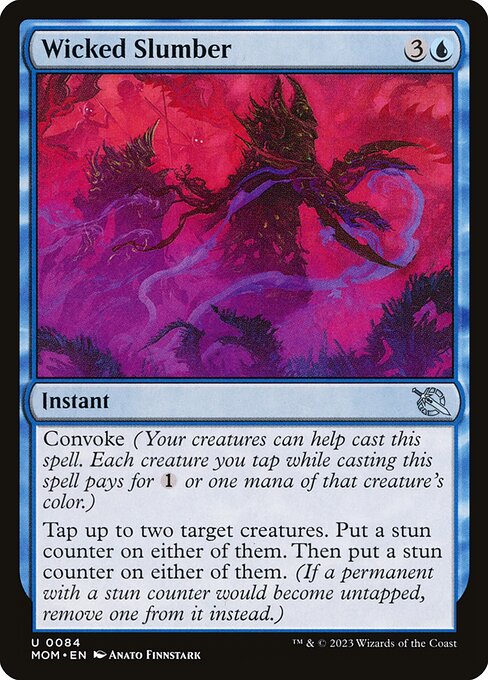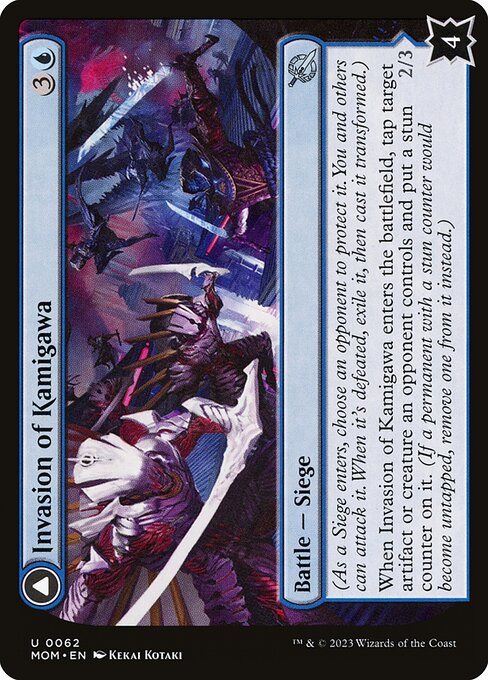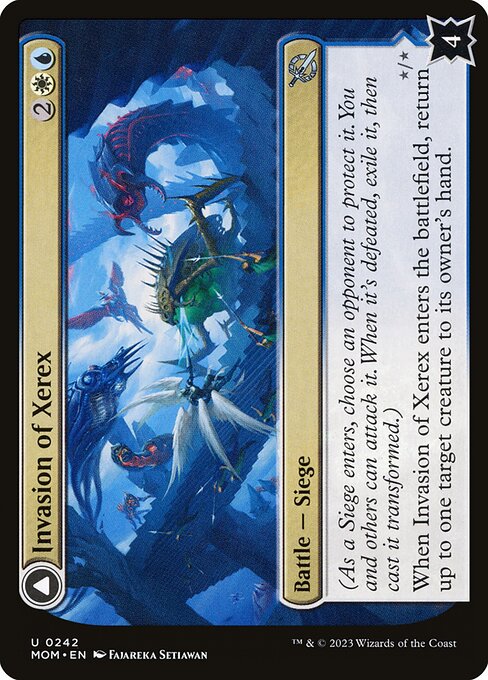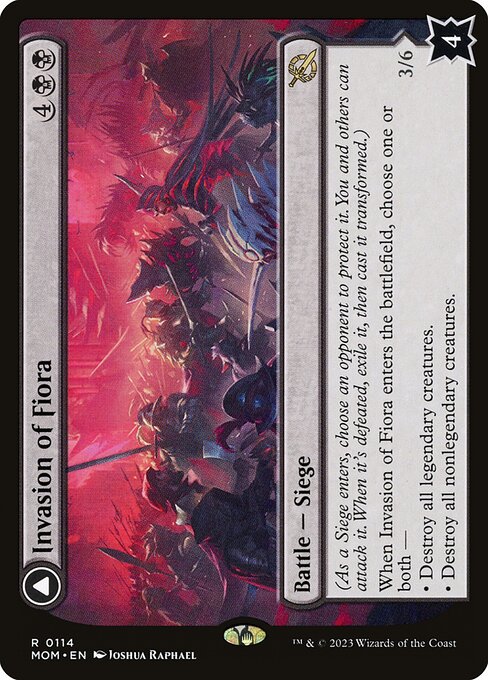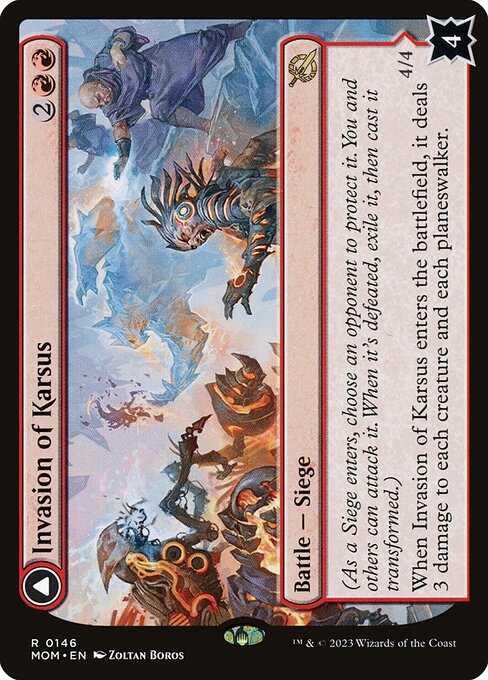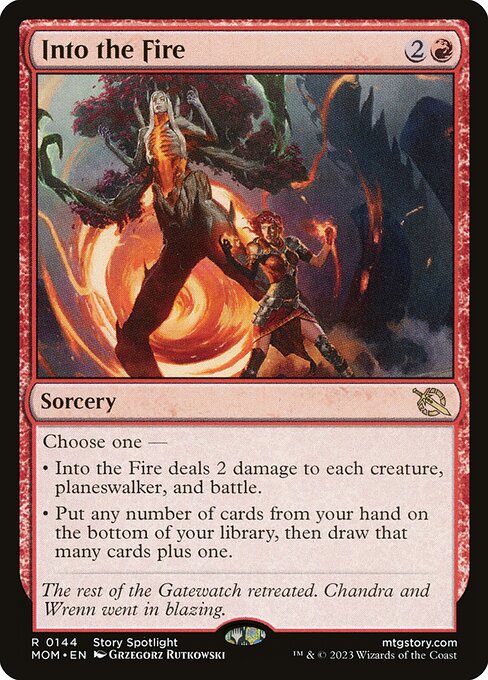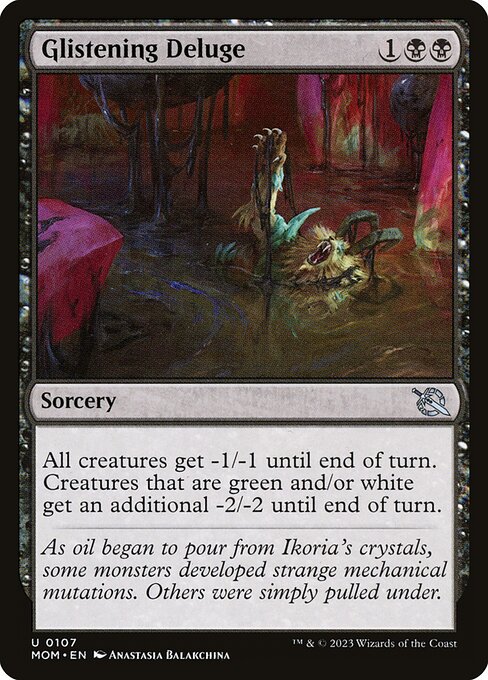Table of Contents
New format is upon us and it seems removal is as important as ever with many bombs and battles changing equation. Opening up opponents for even a small hit can lead to flipping the new card type, Battle and gaining large advantage in the process. Battles are costed so, that the front side of it is rarely worth its cost, but a flipped battle is a mana bargain worth fighting for.
March of the Machine (MOM) Limited Guides
- Five-Color Archetype Guide - New!
- Tier List
- Archetypes Guide and Example Decks
- Battles Guide
- March of the Machine: The Aftermath Guide and Review
- Arena Open
- Draft Guide
- Combos and Synergies
- Underperformers and Overperformers
- Mechanics Guide
- Removal Guide: Unconditional Removal
- Removal Guide: Conditional Removal, Tempo and Sweepers
- Sealed and Prerelease Guide
- Multiverse Legends
- White Review
- Blue Review
- Black Review
- Red Review
- Green Review
- Artifacts, Lands, and Multicolor
And removal can be the tool you are going to use to flip the battles in your favor, either literally by flipping the battle, but also by blazing the trail for your creatures to connect with it. In the last text I talked about the unconditional removal spells, this time it is time for less absolute or less specific ways of dealing with opposing creatures.
Toughness Targeting Conditional Removal
Toughness Targeting Conditional Removal (TTCR) is the most common type of removal spells. You either deal some amount of damage or give an opposing creature -X/-X in order to give kill it. The cost of those spells is largely dependent on the amount of toughness a spell can deal with, thus a fraction of threats it can deal with.
March of the Machine (MOM) has a wide range of spells that target toughness covering a range from 1 to 6. This still means that some creatures, like Etali, Primal Conqueror, will dodge all of the fixed value conditional removal spells. How does damage dealt translate into efficiency?

On the graph above you can see examples of toughness targeting spells and a fraction of creatures of each rarity they kill. So Volcanic Spite can deal with 75% of common creatures* but only 30% of rares. This number seems particularly important. In the last few sets a spell dealing 3 damage would deal with ~60% of rare and mythic creatures, so high rarity cards are significantly bigger in MOM than in previous sets.
This combined with higher prevalence of rares (1.34 per pack rather than the usual 1) and one of the slots in the booster dedicated to, often powerful, higher rarity legendary creatures, can mean that you might want to make sure you do have removal that can deal efficiently with larger threats.
*Technical note: I looked at front side of cards only, excluding transformed creatures and back sides of Battles.
The toughness based removal is normally focused in Red, almost exclusively as direct damage spells, Black, as a mix of -X/-X effects. There are usually some fight (creatures exchange damage) and bite (your creature deals damage to opposing one) spells in green and some damage to creatures involved in combat spells in White.
Red TTCRs
At common and uncommon level red has quite a selection of direct damage spells.
Two spells can deal 1 damage to a creature: Invasion of Regatha and Lithomantic Barrage. But there is more to either of those than ping for one. Invasion will also ping another Battle for 4 and if there is no target for it, can go face. If you defeat it, you are rewarded with a 4/4 prowess creature that boosts all your burn spells with extra 2 damage.
That is a lot of stuff on a Battle but its capability as a removal is somewhat limited. It kills only a quarter of commons, if even that with backup +1/+1 counters and transform potential. The initial numbers on the card are slightly middling, so I would suggest not prioritising it, but keep that it may have a place in some battle-centric UR or RG decks at the back of your mind if you see it later in the draft.
Lithomantic Barrage can deal 1 damage to anything for a fair price of 1 mana. But if the target is blue or white, it does 5 damage instead. On top of everything, it can’t be countered which gives you some piece of mind and deals with pesky abilities like Ward on top of everything. Due to that 5 damage mode, it can kill a surprising proportion of creatures for the 1 mana investment: 55% commons, 37% uncommons and 30% of rare and mythics. Those are numbers similar to deal 2 damage spells in this format. But deal 2 damage has a different distribution of hits.
In every matchup you will have a range of creatures to target with unkicked Final Flourish, but Lithomantic Barrage will be either excellent, where you can trade 5-6 mana creature for your 1 mana spell, or terrible in games where it rots in your hand with no targets. That is why, unless you have a lot of loot or rummage effects in your deck, I would leave it out. But definitely the card is excellent in BO3 draft where it becomes a great sideboard card.
In the two damage slot, Searing Barb is looking slightly underwhelming. 3 mana for 2 damage at sorcery speed and a potential 1/1 creature in the future is not something I would want to play. The early win rate doesn’t look amazing either at ~53%. But again, in a scenario when I want to flip Battles using burn or the Incubator token has additional value for some sacrifice outlet – it may be slightly better and better enough to warrant playing it in my deck.
Volcanic Spite is a totally different story. One mana less, one damage more. Dealing with 75% of common threats, 78% of uncommons. Potential to swap a useless card for something else is a great upside. And potential of killing a Battle in combat? In one of my first drafts I flipped my Invasion of Amonkhet before blocks, having the back side creature enter as a copy of a creature with Backup 1 and Double strike.
Bringing 2 double strikers into combat changed the outcome completely and that is a mode of Volcanic Spite you shouldn’t ignore. And early data does support it – 59% of Game in Hand win rate puts it in the top common bracket with few others. Pick that card early without too much stress.
The last two C/U damage spells in red both have Convoke. Stoke the Flames is a reprint. 4 damage to any target, with its cost made easier by both Convoke and multiple UR creature token makers in the set looks like a great deal. But at least the initial win rate is solid (57.6% to 17Lands.com users 56% average) but not amazing, mainly due to Red underperforming in the data. Keep in mind it is early days, so some big swings may happen before the format fully matures. Jumping into conclusions too early can damage your win rate, but also reduce the fun you are having, if you rashly decide the format is bad. Stoke definitely has potential and needs help from better, streamlined builds of red decks to reach full potential.
Shatter the Source is in the same situation, but its win rate is actually below par. 53.2% doesn’t look great but same caveats apply to it as to Stoke the Flames: UR convoke builds where the card should be at its most powerful may take time to perfect.
The rare burn spell, Nahiri's Warcrafting, looks good on paper. 5 damage for 3 mana is a lot and ability to draw a card in the right conditions looks appealing. But the win rate is not impressive at around 56%. One reason is red being the weakest color so far and Warcrafting is a very high pick so you have to potentially sacrifice better cards to pick it while at the same time needing to be heavily red in order to play it due to the RR in the cost. It seems to me that this card would have been much better with 2R cost.
Black TTCRs
Unlike Red, black is one of the strongest colors in MOM so far. And part of the strength lies in the strong removal suite. Removal spells are top Black cards in the early format data, and the TTCRs are not exceptions from that. Final Flourish is maybe slightly overcosted for a -X/-X spell, but combine it with a cheap way to deal with large creatures and plenty of things to sacrifice for its kicker cost and you get a very good card. All adds up to a very impressive 58.7% win rate across all archetypes, second only to Deadly Derision for a Black common and in top 10 commons for a format as a whole.
Collective Nightmare tops that easily. Solid ability and convoke at instant speed make it an excellent removal spell. The ability to get free mana and be able to deploy threats while targeting opponent’s creature is something that is often underrated. Being able to use more mana than the opponent is a factor that helps winning games – I showed in my earlier analyses that amount of mana spent links strongly with the ability to win games and Collective Nightmare is a great tool to achieve it. And 60.4% GiH Win Rate, top uncommon spot, seems to confirm that this rule still stands.
Failed Conversion, on the other hand, doesn’t impress. 5 mana for sorcery speed -4/-4 removal is not even close to the rate of the other two cards, and the Surveil bonus doesn’t cover the difference. Still 54% GiH WR is not terrible, but that is a card you want to be putting in your deck as a last resort or if you have some enchantment/aura synergies only.
Last TTCR in Black is the Invasion of Ulgrotha. A battle that drains the target for 3 and has a bonus of being able to turn into a 3/3 evasive creature looks appealing but so far doesn’t impress. 56% GiH WR is fine but not excellent. Still you probably won’t cut it from your black deck, but other removal spells in Black look much better.
Green TTCRs
Green TTCRs are usually fight and bite spells, which means their efficiency is directly linked to the sizing of your creatures. In a deck with small creatures they become much worse. They are also naturally laden with high risk: opponent’s removal spells have the potential to fizzle your bite spell and kill your creature at the same time, making you 1 for 2 on the exchange. That is why you should always be careful playing with such types of spells.
Still in MOM both the common and uncommon bite spells look really solid. Cosmic Hunger is the 2nd best common so far with 57.6% WR and Tandem Takedownis the top 3 uncommon with 58% win rate. In both cases you have to be careful not to put yourself into a disadvantage, but also in both cases you can ambush your opponent by flipping your battle on their turn – an option, which if exercised carefully can completely swing the game in your favour.
On the other side of the spectrum you have Invasion of Muraganda, the Battle with a fight spell tagged onto it. This card is overcosted for what you normally pay for such effect, and the creature on the other side is not particularly appealing, which is likely the reason for the unappealing 53% WR.
Herbology Instructor, although technically Green, gets its removal capacity from its Black flip effect. Do not worry, though, you can play the Instructor in any deck, as you can pay 2 life in order to flip it if you don’t have Black mana. A 1/3 body that gains 3 life is an excellent defensive stat line. Defensive stat lines will make sure you will live long enough to flip it, and paying 6-7 mana without any card investment in order to kill something while making your creature from annoying blocker into a potential attacker is a very good ability. Data does reflect that, 57% WR is solid for a Green card in MOM.
White TTCRs
Only one TTCR for White in the format and it does require more than just having a target. The target has to be bothered to be involved in combat, which in case of some utility creatures which are happy to stay on board and accrue value is not the case. Additionally spells like this are very mana efficient but the reason for that is, they won’t clear the path for your attacks like regular removal does. You still need to force blocks, meaning that opponents will sort of gain life through the blocks. This is why normally such cards are better defensively as a cheap way of stopping attacks from the opponent. As such, Elspeth's Smite can be pretty good. The Win Rate is not impressive, at 54%, but cards like that are regularly played in decks where they do not fit, so if you use it wisely, Smite can be better than data suggests.
Other Conditional Removal
Not all conditional removal attacks toughness. Some targets power, some mana cost, some tribal or sub-types. Those types of removal will be very set specific – for example spells that kill artifacts will go from a main decks staple in artifact heavy sets, to a rarely used sideboard card in sets with no important artifact creatures. MOM has several interesting conditional removal spells spread across multiple colors.
Mirrodin Avenged is a card that fools me every time. Every time I hope that the design team nailed a format where this type of the effect will be good, and every time I am proven wrong. So far. One day it will happen. But not this time. Like in NEO, in MOM this type of the effect is not powerful enough. Working hard to exchange cards 1-for-1 is just not good enough in a format where 2-for-1 exchanges are ruling supreme. And 51.5% win rate says clearly – Avenging Mirrodin is not something you want to be doing.
Vanquish the Weak is capable of killing a surprisingly large fraction of common and uncommon creatures, as 80-85% of creatures at those rarities have power 3 or less. This drops to 50% for rare and mythic creatures, but still Vanquish is a solid addition to any black deck, a top 5 Black common and something you should be happy to play in your decks, only a slither below Deadly Derision and Final Flourish.
Invasion of Azgol is a specific removal – the condition is to limit opponents board to only things you are happy to kill. But it can be a perfect turn 2 play, where you snipe opponent’s 2 drop and give you some board presence that threatens to flip into a threat. That is a good deal for 2 mana and win rate of 58% confirms it. You will be very happy to play the card in your BR decks. Especially since it does go a bit late in drafts so if you are in BR aleready you may be rewarded by picking it later in the pack.
Invasion of Lorwyn is on the other side of the spectrum, 6 mana but the condition is so generous it will practically work as an unconditional removal in the format. Still, keep in mind 7 Elves in the format including a very powerful Glissa, Herald of Predation among them. But 6 mana is a lot and the backside is going to be a very large creature , but ultimately easy to keep at bay by chump blocking. So far the card has a middling win rate of 54% but I expect it to increase slightly as the controlling BR or Sultai builds improve in their understanding of the format.
I am not a big fan of Cut Short-style removal in general outside of controlling decks. But MOM is pretty bomb heavy and ability to deal with any massive bomb opponent chuck in your direction is probably something worth the cardboard it is printed on. And Convoke means it can be a blowout in games where opponent thinks they are on the cusp of breaking a board stall. So far it has solid but not impressive stats at 55% WR.
Atraxa’s Fall is one in a long line of spells that kill Flying creatures, artifacts and enchantments. Almost every set nowadays does have a version of that spell and sometimes they are really good. In this iteration you can also kill a Battle opponent selected you to defend, if you are worried flipping it will put you too far on the back foot. But turns out MOM is not a format for Broken Wings, 50% win rate and place among the worst Green cards is suggesting you should avoid it.
Tempo Removal
Tempo removal is a broad category of spells that don’t get rid of a creature permanently, but buys you time, either to win a racing situation or in order to buy enough time to stabilise in other ways. Tempo removal is traditionally the domain of Blue with some splashover to White. And since blue looks like the best color in MOM so far, it is worth to look at tempo plays in-depth.
Ephara’s Dispersal is a very flexible spell. Amazing tempo play in a racing scenario when cast for 1 mana. Makes a nightmare for opponent to play around it if they are attacking. And still Surveil 2 makes it so it is decent for 3 mana. This card is one of the reasons for Blue performing so well in the early data. 62% win rate for a common spell is amazing, and surprised me even though I was pretty high on this card in the preview season. And the card still wheels around half of the time if you open it in the pack (to see how to estimate the probability of wheeling a card based on 17Lands.com data, check this article).
Valuing and being able to utilise this card well is a difference between players who are still learning how to draft and experienced drafters. You can practice those skill with Dispersal and use MOM to level up in this aspect of game play while Blue is a strong format to get ready for using similar strategies when it is more difficult to do so.
Temporal Cleansing is another effect that is often underestimated by newer players. Putting something on top (or close to) of opponents library is very different than bouncing. Opponent will not only have to pay mana, lose time but also waste a draw step, which is a big difference. Sometimes they will opt to put it on the bottom, so Temporal CLeansing will be a straight up removal then. Normally those types of effects are better at instant speed, but Convoke adds to Cleansing’s appeal. 58% win rate is good and it adds to a wide range of powerful Blue commons. Don’t sleep on this card.
Wicked Slumber is another Convoke tempo play. You can clean the path to attacking, stop opponent racing, make sure ou flip a battle and much more. Still, win rate of 56% is good but not amazing, Stun not having advantages of bounce or putting on top of library: it doesn’t require opponent to use mana for replaying the same spell again. But a card is solid and should be played.
On the other hand, Invasion of Kamigawa is not great. 4 mana for stunning one creature at sorcery speed is a much worse effect than stunning 2 creatures Slumber offered. And the reward for flipping the battle is not that great. 2/3 Thieving Magpie (yes, I am old) is just not good enough a reward. Win Rate does reflect it, 50% for a blue card, especially in this set where blue shines, is really bad.
Invasion of Xerex shows you exactly why bouncing is better than stunning. Turns out that making opponent pay 2-3-4 mana to replay their creature is enough to increase the win rate from 50% to 56%. OK, probably the fact that the creature on the back side of Xerex invasion is better than the one from Kamigawa is also important. But you get what I mean. Xerex – yes, Kamigawa – no.
Sweepers
For me sweepers are cards that kill, without discrimination, all creatures on board that fulfil a certain condition. In best case, that condition is “it is a creature”, which means it sweeps the whole board. Those are powerful effects so sweepers are usually at higher rarities, at least uncommon for conditional ones and often rare and higher.
In recent year several sweepers let you play with their conditions to try to maximise your effect (Think Farewell) of gave you a sort of board presence instantly after the board wipe (think White Sun’s Twilight). And those types of sweepers turned out to be really powerful cards. The MOM design team decided to continue that trends with two cards that fall into those categories.
Sunfall is, so far, the bogeyman of the format. Curently standing at 70% WR – it is one of the most powerful cards in the whole set, if not the. And at only rare you will bounce into it more frequently than you will probably want to. Ability to be able to play into the board and still feel good about wiping the board as creatures you lost will contribute to the power of the Incubator you can flip next turn will make it harder to detect if opponent has it in their deck, which is very annoying on a sweeper. Sunfall is backbreaking. First pick it whenever you see it.
Invasion of Fiora is a more crafty sweeper. You can play some legends and keep the board, increasing the probability of flipping the invasion, you can use it as a 6 mana removal for opponents busted legend, and many options inbetween. Not as high win rate as Sunfall despite being in a better color but still 62% WR is impressive and makes Invasion of Fiora another first pick.
Red sweepers are usually damage based and MOM is not exception. Invasion of Krassus deals 3 damage to everything. Which can be great but has downsides, meaning you probably want to build around that card. Prioritise 4 toughness creatures, avoid expensive spells with 3 toughness, manage your board state not to overcommit if you want to maximise its impact. The flip side is a very good creature, which is the reason card has a solid 57% win rate so far. It can be a decent role player in a more controlling version of a red deck, but maybe more of a reward of being in that particular lane than a reason to be in it.
Into the Fire is an interesting design. An early sweeper against aggro decks that can be cashed in for some extra card draw later in the game when it is no more useful. And I am pretty sure it would have been great in an attack based aggressive format like ONE but in MOM it looks like it is a miss. 49% WR is not enough to convince me to play it.
Glistening Deluge is a situational card. Great if you play against GW but not so much against other color combination. This means that most likely it belongs to the sideboard rather than main deck and should be used only in BO3 drafts. There is still not enough BO3 data for that card in order to get the win rate, but in BO1 it performs poorly, so I would avoid it there.
Conclusions
Removal is a very important part of this format – all types of it play important roles in game plans for each color combination. Hopefully this piece will help you getting your early footing in the format, but if you need more, why not checking my first look into MOM data? It will be worth it to get the early info in as the format looks like a very good draft set and also a potentially very fun set to draft with many buildarounds and quirky but successful one in a 100 drafts build you can try to get.
I was already killed by a very unlikely Auras deck – loosing to it didn’t even hurt as what opponent was doing was impressive and cool. On the flip side I managed to get a poison kill in MOM, something that eluded me in ONE, courtesy of a collaboration between Skithiryx, the Blight Dragon and Fynn, the Fangbearer. And this is just the tip of the iceberg of what you can do in MOM.





